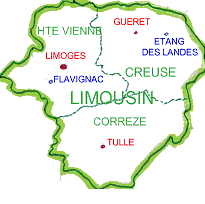You can return to the map of European sites by clicking here, or select a site from the list in the left menu.
Saison 2025/2026
Flavignac
Informations : Patrick Précigout
| Date | Nombre |
| 11/11/2025 | 9 649 |
| 9/11/2025 | 18 |
| 5/11/2025 | 120 |
| 4/11/2025 | 987 |
| 30/10/2025 | 1 381 |
| 28/10/2025 | 175 |
| 26/10/2025 | 792 |
| 25/10/2025 | 261 |
| 18/10/2025 | 758 |
| 16/10/2025 | 92 |
| 13/10/2025 | 31 |
The Limousin area is made up of three departments: Haute-Vienne (area capital for fire arts and porcelain), Creuse (Gueret) and Correze (Tulle).
Some geographical contrasts:
The area is made up of a layered landscape of plains, plateaux and mountains from west to east, with a basin in the south:
- some mountains in the east with a peak at 976 m: the Mont Bessou in Correze,
- some terraced plateaux from 300 up to 700 m high around the Limousin mountains,
- the Brive basin, a rich land and a door towards the South.
The Kingdom of trees and water:
Water is omnipresent in Limousin with:
- two large hydrographical basins: the basin of the Loire in the north and the basin of the Garonne in the south,
- three large artificial lakes: the lake of Val (north-east of Correze), the lake of Vassiviere (Haute- Vienne and Creuse) and the lake of St-Pardoux (Haute-Vienne),
- numerous lakes on which cranes sometimes stop for a while in order to take rest during the
migration (some immature cranes sometimes stay a bit longer, particularly in the spring).
The forest covers a third of the territory. The broad-leaved trees (beech, oak and chestnut trees) represent two thirds of the wooded surface whereas the evergreen trees are rather located in the mountain areas.
A mainly oceanic climate:
The climate changes according to the altitudes:
- on the Limousin mountain: a more continental climate,
- on the plateaux: a transition climate with a strong oceanic predominance,
- in the Brive basin: an Aquitaine type climate.
Agriculture :
The area is famous for its livestock farming (Limousin cows, sheep, ...).
The regional nature parks and the national nature reserves:
Thanks to a territory with natural, cultural and human resources, the Limousin has two regional nature parks:
- the regional nature park of Millevaches,
- the Perigord Limousin regional nature park on which the site of Flavignac is located (Long: 01°03'18''E - Lat: 45°43'53''N),
as well as two national nature reserves:
- Tourbiere des Dauges (Long: 01°25'17''E - Lat: 46°00'42''N),
- Etang des Landes (Long: 02°19'29''E - Lat: 46°10'49''N) located at Lussat in Creuse. The largest lake of the Limousin (100 ha) has some exceptional ornithological resources. Numerous cranes take a break there before starting again their migration.
The Common Crane:
This emblematic bird arouses many passions. The Limousin is entirely swept by the west migration corridor of the Common Crane, with a higher flight frequency over Haute-Vienne and Creuse. We can estimate that the majority of the cranes wintering in Spain and in the South of France (140,000 to 200,000 cranes) flies over our area.
Flavignac:
The site of Flavignac is located at the axis of the migration corridor at 25 km north-west of Limoges.
For around twenty years, numerous ornithologists have observed there many birds. One of the first ones has been Patrick Labidoire. For around ten years, the site is lead by an ornithologist of the village: Patrick Precigout.
The site is a real lookout tower for this corridor crossed by many birds, with two main bird-watching places at around 350 m high:
- for the postnuptial migration: near the hamlet of Cessaguet which is an open space towards the north-east and from which the city of Limoges can be seen,
- for the prenuptial migration: near the hamlet of Eynanças.
A continuous presence is carried out during the migration period, particularly by Patrick Precigout and Jean-Louis Vareille who operate an accurate counting of all the birds and particularly of the Common Cranes.
The site of Flavignac has henceforth joined the Reseau Mission Migration (www.migraction.net).
Information: Alain et Sylvie GENDEAU
(Reseau Grues France)
